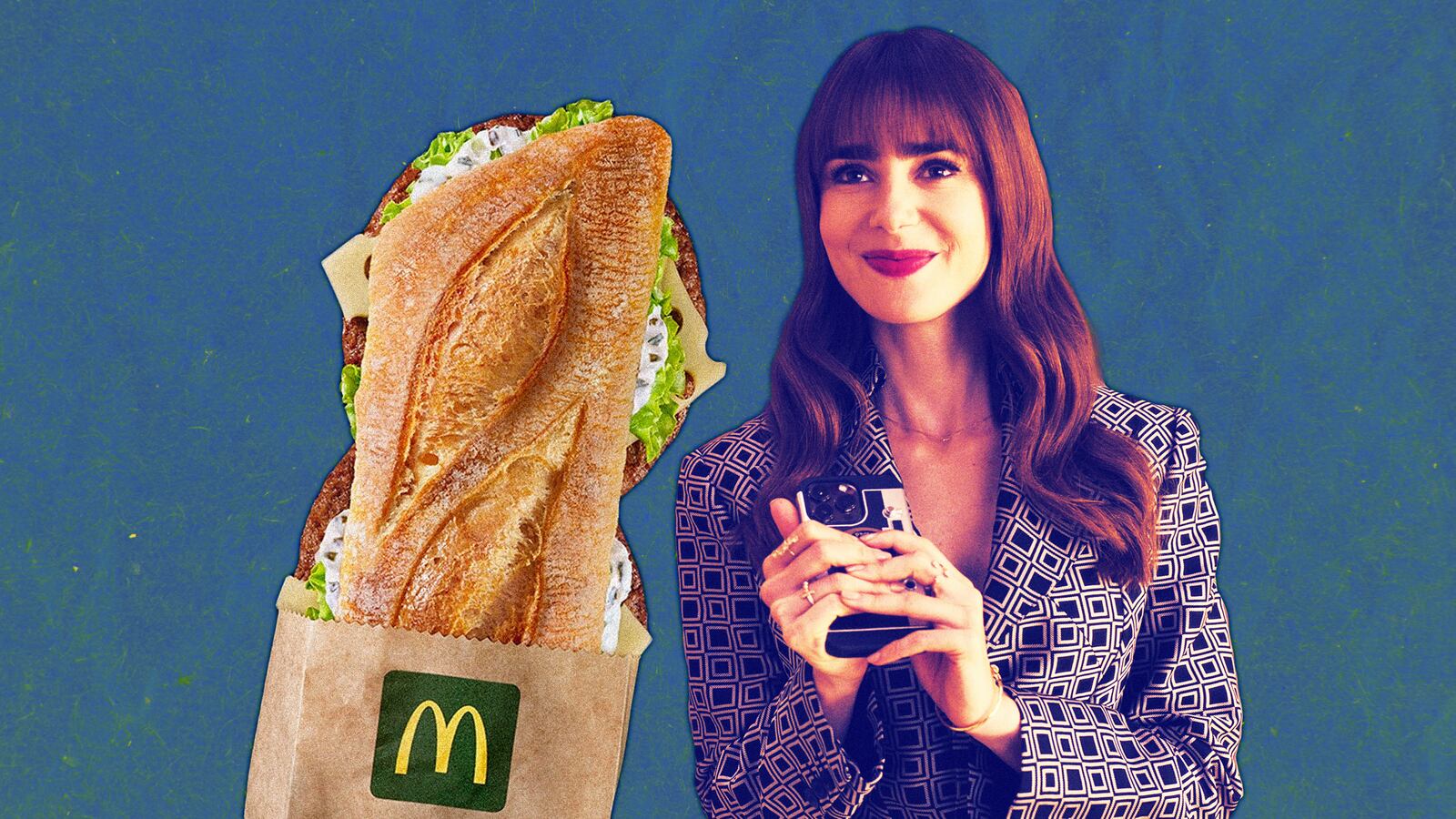Ask any Parisian, American expat abiding in the picturesque country, or Emily in Paris herself (Lily Collins), and they’ll tell you: The McBaguette is a special, limited time only, exclusively French dish. Folks go running to the nearest golden arches the minute they hear of its return. The McBaguette, exclusively offered at McDonald’s France, is like a local spin on the McRib. And just like the McRib, French people fawn over it while it’s available.
At least, that’s what this season of Emily in Paris wants us to believe.
“I can attest that I never saw anyone else order one while in Paris,” vlogger Hannah Tyson, an American who lived in Paris for part of her graduate program in early 2021, tells me over Instagram DMs. She made a video last year in which she tastes the McBaguette—she’s not a big fan—which I watched after the first episode of this new season of Emily in Paris. I’ve never tried a McBaguette, as it’s a French McDonald’s exclusive. But Emily in Paris is set to convince countless Americans that they’re going to want to try one, thanks to an episode dedicated to Emily’s marketing campaign for it.
The McBaguette is basically a double hamburger. Two patties are placed side by side on a baguette (which has been newly added to UNESCO’s “intangible cultural heritage” list), slathered with Dijon mustard, and topped with Swiss cheese and lettuce. The McBaguette first launched in 2012, with splashy advertisements and plenty of tongue-in-cheek reporting from American news outlets.
Nearly a decade later, Emily in Paris’ third season is bringing the McBaguette back. This season, Emily locks down a McDonald’s account thanks to her ex-boyfriend in Chicago, who tells her the company is looking for a French marketing agency to launch the McBaguette. “Everybody’s going to want this,” Doug tells Emily on the phone, “but it’s all teed up for you.” Hottie chef Gabriel (Lucas Bravo) then takes her to a French McDonald’s to convince her of how “chic” the fast food chain is overseas—because, you know, 5-star chefs love McDonald’s.,
Gabriel tells Emily that McDonald’s is un petit plaisir, a little luxury, which gets her to lock in the marketing campaign. While dining at the top of the Eiffel Tower, Emily settles a deal with a McDonald’s exec; they’ll use the song “’S Wonderful” by George Gershwin, but replace the main word with “McWonderful, McMarvelous, McParadise, McBaguette.” The (fictional) McDonald’s exec is lovin’ it.
And the real French McDonald’s is lovin’ the feature too. The chain has already begun rolling out a special menu themed to Emily in Paris, days after the season premiered. The menu includes the McBaguette itself.
Though the McBaguette isn’t yet confirmed for American McDonald’s, who’s to say we don’t deserve a taste?
But instead of trying to recreate the meal ourselves, The Daily Beast’s Obsessed chatted with folks who have spent plenty of time in France, and who have made videos tasting the McBaguette, to walk us through the taste, cultural impact, and relation to Emily in Paris. That includes Oui in France blogger Diane Wargnier and The Francofile vloggers Jalen and Maria (who prefer to go by just their first names), along with Tyson. Alex Dreyer, an American chef living in Paris who teaches bread-making classes—and was featured in one of the first news clips on the McBaguette—also shared his thoughts on the legacy of McDonald’s abroad.
So, is the McBaguette worth booking an overseas trip to Paris? Or should you avoid it at all costs? And how do Parisian chefs feel about it, and McDonald’s in general? Here’s what we learned about the McBaguette.
Neither Netflix nor McDonald’s responded to The Daily Beast’s Obsessed request for comment on this story. The following conversation has been edited for clarity and length.
How did the McBaguette become an iconic item at French McDonald’s?
Maria: I first heard about the McBaguette in one of my high school French classes. I remember being intrigued by the differences between the French and American McDonald’s menus.
Diane Wargnier: I first heard about the McBaguette shortly after moving to France in 2012. The flagship sandwich makes a reappearance every so often and isn't something that's permanently available at McDonald's in France, like the Big Mac. When it makes its return, you'll see ads for it at bus stops, and it seems to be pretty popular.
Hannah Tyson: Unfortunately, [my classmates and I] were studying abroad in the middle of COVID’s peak in Winter 2021. At that point in France, everything was still closed down: bars, restaurants, museums, and clubs. The only way to get food was takeout and Uber Eats, so my roommates and I often found ourselves at McDonald’s. The first time we went, there was a huge advertisement for the McBaguette on the wall. I found it hilariously French, and I immediately knew I had to try it in a YouTube video.

You went on to make content about the McBaguette. What do you find particularly fascinating about this special sandwich?
Jalen: [Maria and I] wanted to make a video about the McBaguette because it combined French and American culture in an amusing way. Eating a French-style sandwich from a fast-food chain associated with our home country was a fun cultural mash-up to show our international audience.
Wargnier: The McBaguette is one of those things that you find only in France and was a limited-time sandwich adapted to the French market. I thought that was interesting, just the novelty of it, since a McBaguette wouldn't work for the American market, and [I] wanted to see if [McDonald’s France’s] flagship sandwich was any good.
Americans are always surprised to learn that the French are huge fans of McDonald's and that the drive-through lines—even in smaller towns—are always huge. France has over 1,500 McDonald's and the French are the chain's second biggest market, right after the U.S., if I'm not mistaken. It's important to me to show the ‘real’ France and not romanticized versions of how a certain percentage of French people live in Paris.
Tyson: I have to give McDonald’s credit where credit is due—the McBaguette is incredibly creative.
Does the McBaguette live up to Parisians’ expectations of the bread?
Alex Dreyer: Over the years, [bread] has become a staple in French culture. Traditional French bread is large loaves, they’re for families to share. In Paris in the early 1900s, there are many folkloric stories about the baguette. One of the stories is that a lot of people from rural areas came to Paris to build the metro, and everyone had a knife on hand to cut the bread, which led to knife fights on the metro. So they wanted to make individual bread that you could tear apart.
The baguette, like a lot of words in Paris, the word is just a shape. It means ‘a stick.’ Does [the McBaguette] look like a stick? Possibly. It’s shaped like a baguette. But the other word that comes with it is ‘traditional,’ which relates to the flour. The flour used is not going to be a traditional flour.
When in Paris, is the McBaguette worth a taste?
Jalen and Maria: While we enjoyed both the authentic McBaguette and our homemade version, we haven’t eaten them again since we made the video two years ago! We prefer to get classic baguette sandwiches from French boulangeries instead.
Wargnier: I'd recommend that people get their sandwiches at a bakery (boulangerie) for an authentic French experience. Look for independent bakeries that make everything in-house and steer clear of chains for the best quality. The bread will be excellent no matter what sandwich you get ,and you really can't go wrong. Most are served on a fresh baguette, and ham, chicken, and tuna are really popular. A jambon beurre is ham with butter and is really good. You can also get a poulet crudités, which is my favorite and has grilled chicken, lettuce, tomato, and egg with mayonnaise.
Dreyer: The only physical proof of me having [the McBaguette] was back in 2012 when I ate it in front of the camera. I never touched it again. It was not good. It’s industrial bread that resembles a baguette—but it’s not a real baguette, in my opinion.
Do French chefs actually love McDonald’s, the way Gabriel does in Emily in Paris?
Dreyer: [Laughs.] When you get out of the bar at two o’clock in the morning, you’re kind of in support of whatever’s open! That’s pretty much the only support I’ve ever heard [from chefs]. It’s normal people food. People can’t afford expensive food every day, so it’s what they eat.

Is the McBaguette a good fit for a show like Emily in Paris?
Tyson: Both the McBaguette and Emily in Paris are extremely campy—both the food and the series show French culture through an American lens. I may have to watch this season of Emily In Paris just to see the real star—the McBaguette.
Jalen: The McBaguette could be a good fit for a show like Emily in Paris since it takes stereotypical characteristics from both French and American foods and fuses them to create a final product that is fun to consume, but doesn’t necessarily reflect the best of French or American cuisine.
Wargnier: The novelty of the McBaguette piqued my curiosity, and as Emily discovers Paris, maybe she'll be tempted too. McDonald's is a bit different in France, and I think a lot of us foreigners are surprised at just how popular the chain is with the French. Let's see what Emily thinks!
Dreyer: What I search for in my career is authenticity. I think it’s a shame that they didn’t go to a good baker, but that’s just my personal opinion.






